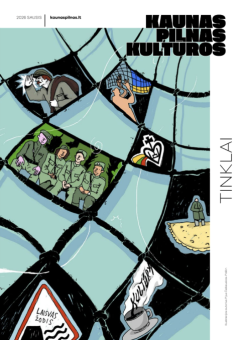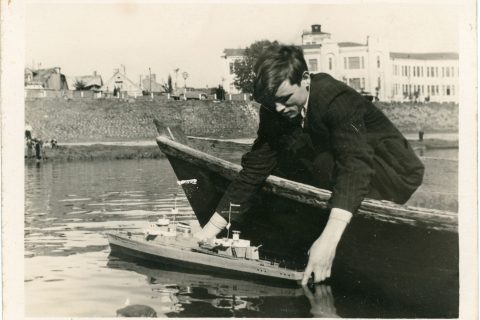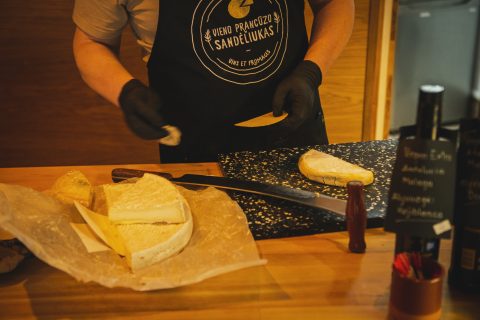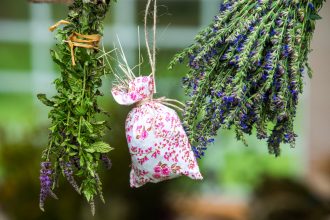Sometimes, without knowing it, in Kaunas we gain supernatural powers and walk on water. In the city, under the streets, the array of garages and office buildings, you can find several small streams able to reveal new urban stories. Architect Rasa Chmieliauskaitė and art critic Dr. Justinas Kalinauskas, the creators of the educational/creative project TẽKA, actively search for these stories and tell them to a wider public.
The creative duo conducts spatial and cultural studies of rivers, riverbanks, and water flows. Rasa and Justinas question the usual ways of getting to know the environment and together invite you to experience alternative approaches, to get to know everyday life that sometimes seems overly familiar. What do streams smell like and what can we learn by following our noses? What can we see when we close our eyes? This interview will try to answer all of these questions and tell you more about the new TẽKA summer season.
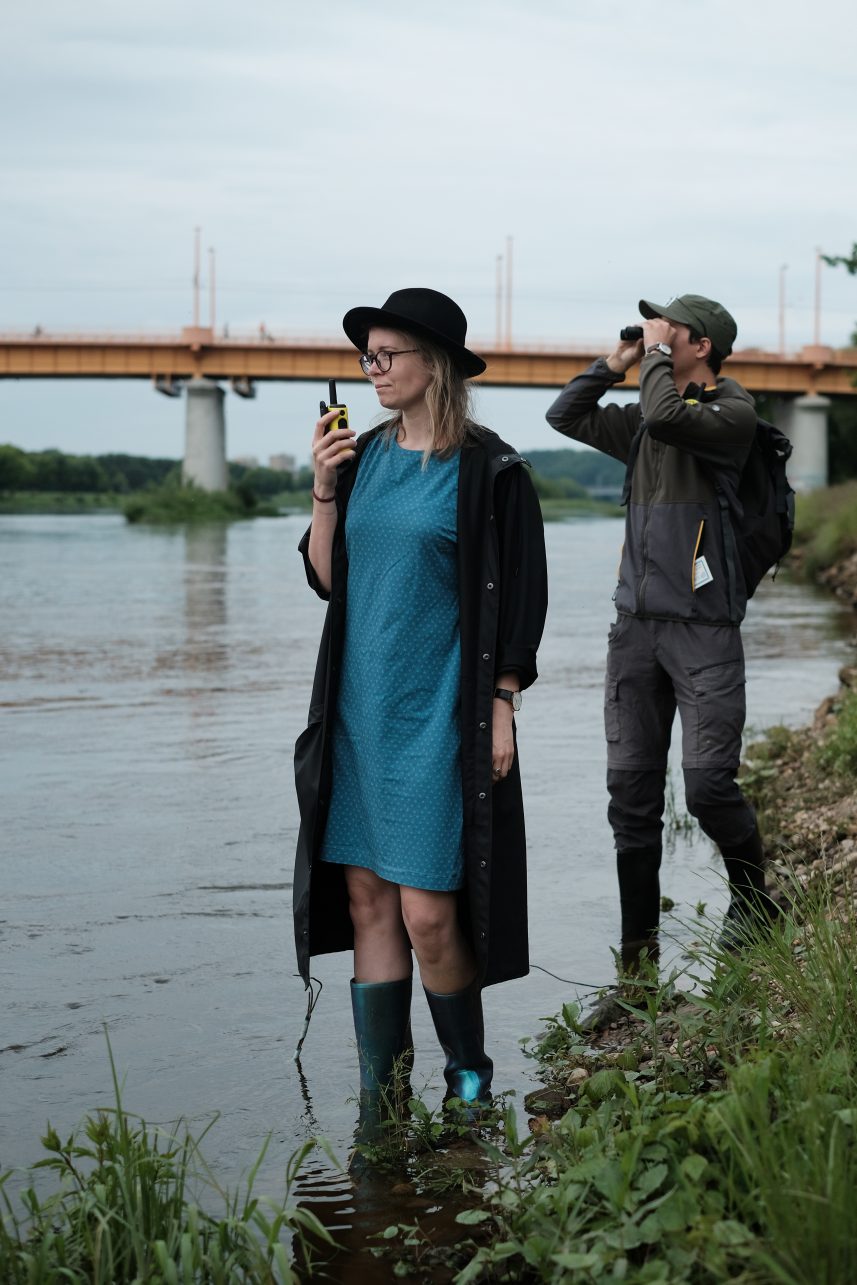
You have been working with the TẽKA project for several years now. Tell me how it all began.
Justinas: The project started with the riverbanks of the Nemunas and the Neris. It was a reaction to the urban regeneration of the new riverbank of Vilijampolė (Piliamiestis quarter) in 2015. During it, the shoreline was re-dug, and the riverbed slightly changed and as a result the contour of the riverbed on the side of the Old Town had also changed. Embankments and slopes were formed with the same hollow Soviet honeycombs. We realized that nothing has changed in 40 years: the riverbank is still managed aggressively and unsustainably. Together with Rasa and Paulius Tautvydas Laurynaitis we started to discuss how the city develops near the rivers. Thus, the attention shifted to the riverbanks, the New Town, Karaliaus Mindaugo Avenue’s riverbank, which did not seem human-friendly or comfortable. We thought about what can be done, what methods and cultural, creative practices to apply to bring more life to the riverbank.
Rasa: At that time, the embankment was managed using outdated methods, although there was no need to invent new solutions, only to adopt the good practices of other cities, of which there are definitely plenty. We had to go to the municipality, make presentations about river management, present positive concepts of regeneration. However, we realized that “hard” transformations are not in our power, and we started looking for ways to use soft power: culture.
Justinas: In the beginning, the river, flowing water was not the main object of our activities. We talked more about the bank, the embankment and the urban cultural relationship with nature at the time. The focus shifted toward the river later. In 2018, we began to pay more attention to rivers and streams, the phenomenon of flow, water, which is not only a phenomenon of the riverbank; we were interested in how water shapes the city and its development as well as the development of city districts located near the small streams and what spaces it creates. Today our main activity is based on rivers and streams. In 2018, we started organizing expeditions on the Nemunas and the Nevėžis rivers and in 2019 along the streams of Kaunas. In 2020, we launched a website www.upynes.lt and presented a virtual gallery of newly discovered streams in Kaunas.
During the TẽKA project Upynės, you organize cultural exploration expeditions along the rivers of Kaunas. In 2020 six streams were visited: Girstupis, Veršva, Sėmena, Amalė, Aukštieji Šančiai stream (no name), Svirbė. Last year, in groups you visited six water bodies: Veršva, Girstupis and Sėmena streams and the riverbanks of Vilijampolė, Šančiai and Aleksotas. What distinctive features, in terms of smells, each of these places has?
Rasa: We mostly “smelled” the streams in autumn, in September and October. It is a very good time to travel along the streams. During the expeditions, we are not walking along the banks, we get into the streams and walk along their bottoms. And it is precisely in the fall that the streams have the least water. Sensing a smell in the stream is not a good sign. Now, the situation is better, but those streams that start in industrial areas, industrial avenues, near car service centers and other businesses, usually have a specific smell. There used to be a general perception that the streams were being polluted by residents who threw their waste in them, yet this habit has almost disappeared because the surveillance has been increased. However, the main polluter, I think, is industry. We often talked about this with local people while walking along the streams. Of course, they were surprised when they saw us in the riverbed. Each stream does not have a specific smell, but they emit the smell of people and their activities. This is how the smells of the outskirts of Kaunas reach the center of Kaunas.



Justinas: Most streams are barely noticeable, the beds are densely covered with deciduous trees, and few people wonder if there is a stream behind these trees, although there are industrial districts, block apartments and other activities taking place nearby. Since it is an area that is quite hidden from prying eyes, it sometimes becomes a convenient dumping ground. Elsewhere, the streams are not visible at all. They are located under parks and squares. There are even streams that flow through underground pipes. For example, the Veršva stream flows openly, it goes down the hill and then covers a long distance under the streets and buildings of Vilijampolė, running through a pipe. Where the stream is not ventilated, the concentration of odors increase. And the situation of the Nemunas and the Neris riverbanks – the largest rivers of Kaunas – is completely different. They are frequented by people and their surroundings are organized and maintained.
Rasa: With the exception of Jiesia, none of the small streams in Kaunas has an open mouth to a large river, all confluences are in the pipes. For example, we fell in love with the Sėmena stream. It is so diverse, full of nature, beaver dams, bends and tunnels under the streets, amateur architecture elements and small bridges. However, its last part flows under an array of garages under the street and only then comes out of the pipe. The Girstupis stream was also culverted in stages. While searching for information, I found a request in which the garage association asks for a plot on the stream and promises to culvert it at its own expense. So, people used to look at streams as territories that could be used. As a result, the Girstupis flows under the arrays of garages.
Which of the streams you’ve explored are the most pleasing to your sense of smell or other senses?
Justinas: I would say the Sėmena. The specific section that starts from Vaidoto Street and continues along Vaišvydava Road. The stream is quite open and clean, there is a pruned forest nearby full of moss, ground elders and a lush forest floor. Driving towards Vaišvydava, you can see the meandering stream very well through the passenger window; there are many bends in that short distance. It is a very romantic place where you can see a cleaned urban stream.
Rasa: The Veršva stream is also very interesting and romantic. Out of all other streams it is the one that smells of the forest the most. It doesn’t feel like it’s urban. There is a sense that you are not in the city but in nature with many animal tracks nearby. There is a lot of interesting experimental architecture, residents have built recreational islands from pallets on the banks. Similarly, in Vilijampolė, on the Neris riverbanks people have built personal “thrones” to spend their time privately near the river.
Asphalt and wet grass – these were the smells of my childhood. Now the city smells different.
Justinas: I think the most interesting spots are not those where smells are positive or pleasant or simply nonexistent but those that have a specific yet non-toxic smell. This spot is the channel of Nemunas Island, it always has a distinctive smell that changes depending on the season. The aroma changes precisely because of the fluctuations in the depth of the river. In August, the yield of the Nemunas decreases, so you can wade in the channel, the water also starts to turn sour, and the smell indicates “stagnant” water. And after a summer rain there is almost always a pleasant smell of grass. The channel of Nemunas Island has its own specifics, its own shape, it is the Nemunas in a different form.
I think maybe the fact that some streams are hidden and have a specific smell adds to the fact that we have few untouched corners of nature in the city itself, for example, the Mickevičius Valley.
Rasa: This is quite an optimistic point of view because the smell does not come alone. Nature shapes the city and at the same time the city shapes nature, so it is necessary to find ways to combine these two things and organically bring them closer to each other. It is important not to look at it radically, there is no need to pave everything in cement tiles but at the same time, nature should not be separated from the city making the riverbanks inaccessible to people. It is worthwhile and necessary to find sustainable ways to create accessible points along the streams that would be dynamic and allow the river to flow and the fauna and flora to live.
What does the body of water bring to the city?
Rasa: A city next to an open body of water always smells completely different than a city that has no body of water, and a city next to a river even more so. The urban microclimate, water, and humidity absorb dust. We are grateful to the river that we have a valley and banks that causes the winds to move differently.
Justinas: Near the streams and rivers, compared to the urbanized area, there is always a large variety of wildlife: birds, insects, deer, hares, and beavers. All these animals have some sort of refuge because, as Rasa said, the territories of small streams are like gray areas, no man’s land where animals can be smelled and found.


This summer you started a new season of TẽKA – On the Other Bank – during which you will open a river post service and invite everyone who wants to send a letter or a parcel to the other bank. Tell us more about the idea.
Justinas: This is the final highlight of our project Upynės, which was carried out and developed for three years. We call On the Other Bank a social river game. This idea was born from the desire to remember and reflect on the history of Kaunas as a port city. Only a few Kaunas residents know that our city was the largest river centre in the region for centuries. Kaunas was associated with port during the period of the Grand Duchy of Lithuania, during the Russian Empire, and during the interwar period. After the hydroelectric power plant was built in the mid-20th century, the water level of the Nemunas dropped, and the depth required for navigation decreased. This is one of the main reasons why Kaunas lost its port city title. But the city of rivers is not just a city with many boats on the riverbanks. In the past, ships performed many functions, one of which was mail. With this social river game, we want to encourage different riverbanks of Kaunas to look at the river from a different perspective and to recall its various roles instead of just a recreational one. We do not aim to create a fully functioning river post or a parcel service, but we aim to use the river during the summer as a communication corridor through which we can communicate and establish a dialogue with the other banks of the river.
In this river mail, we will invite each participant to be both a sender and a receiver, participating in a symbolic exchange similar to exchanging Christmas gifts. Parcels must be safe and not exceed 6 kilograms in weight. The parcel can be practical, such as a jar of jam, but it can also be a text, a poem, a photograph or a drawing. The most important thing is not the material value, but the greeting to the other riverbank. This river mail, which we plan to grow during the summer, is a kind of registration log, where everyone will be able to track the sent parcel, see the place of issue, time and recipient. After the end of the project, this registration system and the created postal infrastructure will remain and serve as a kind of memory archive, which we will be able to remember and recall how the city coexisted with the rivers in 2022.
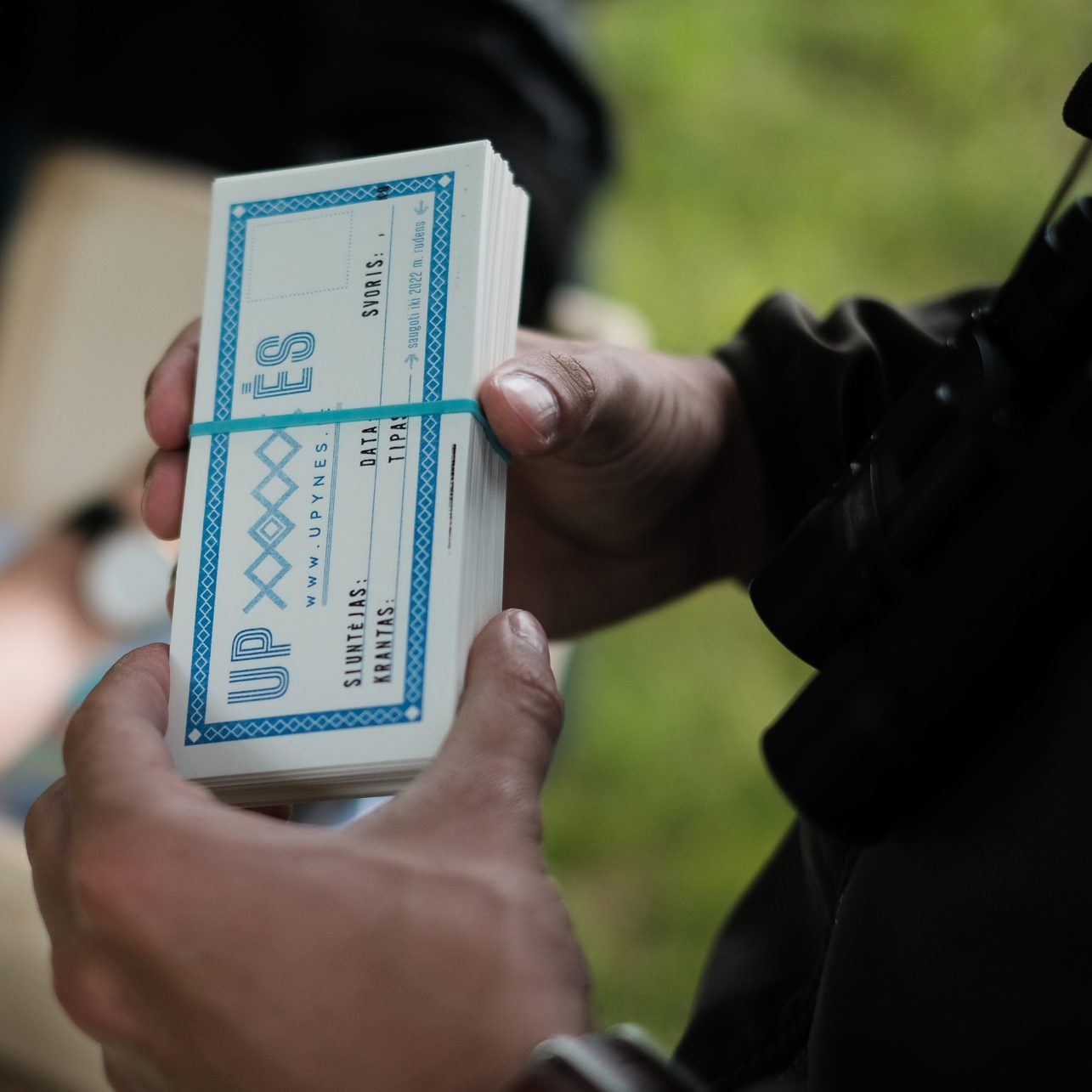
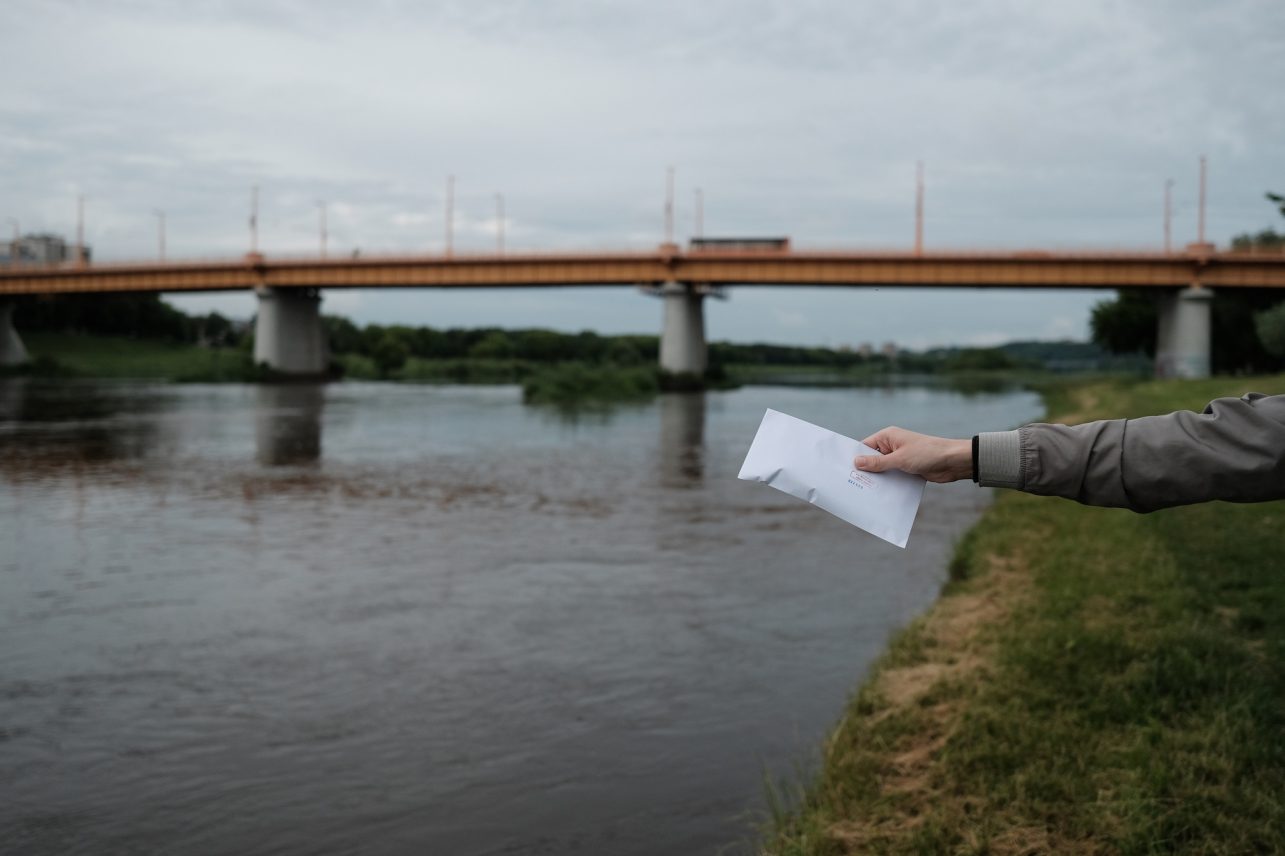
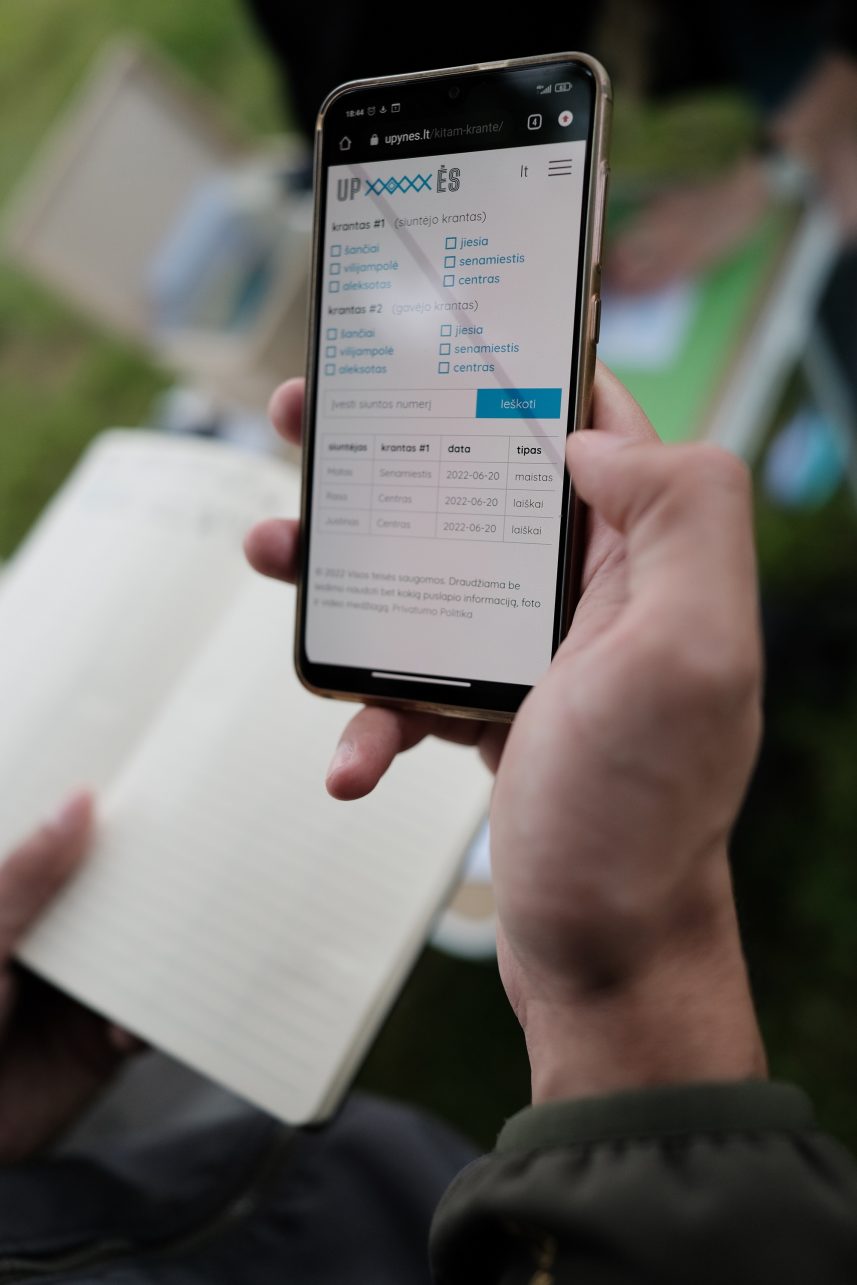
How will the shipments be transferred from one riverbank to another?
Justinas: We will transport the parcels collected in June and July to the other riverbank (there will be six such shores) in August while using our own eco-friendly, pedal-powered boat. It is a 9-meter-long boat of unique design and original production.
You have recently presented the non-visual architecture pavilion Archi/Textūra. It is an experimental piece that invites you to experience the material environment through tactile senses in the dark, non-visually. Why is it important to experience your usual environment using all your senses?
Rasa: One aspect is broadening your experience. Most people’s memories are about what they saw, visual information is the most perceived and processed. In this way, it is difficult to discover something new in your environment, which you have seen many times; you cannot experience the full potential of, say, architecture. With our project, we invited people not to see the architecture, but to find all its other layers. Architecture is not fine arts. Composition, acoustics, materiality, spatiality are very important to it. Invitation and encouragement not to see but feel and touch the architecture, greatly broadens the experience and provides pleasure in experiencing the non-visual aesthetic quality.
Justinas: Both of these projects and a wide range of activities, in one way or another, speak about space and the qualities of an environment and a city as a whole. When we start to look deeper into the space, the environment, then we can move deeper, get to touching, hearing, smelling and discover the tactile and audial qualities. As for nature, by getting involved in learning about the environment, we can find streams that are hidden under concrete and treetops. This is an in-depth study of the city.
Architecture has its own smell, whether it is an attic, a wooden house, or a neighbour’s apartment. Can we say that this is the main value of architecture? What is an architecture-like scent anyway? We are used to talking about the image – architectural image, cityscape – but what is the soundscape or smellscape of the city? We believe that it is possible to speak differently, on a different scale, from a different perspective, using a different vocabulary, trying a different way of experiencing.
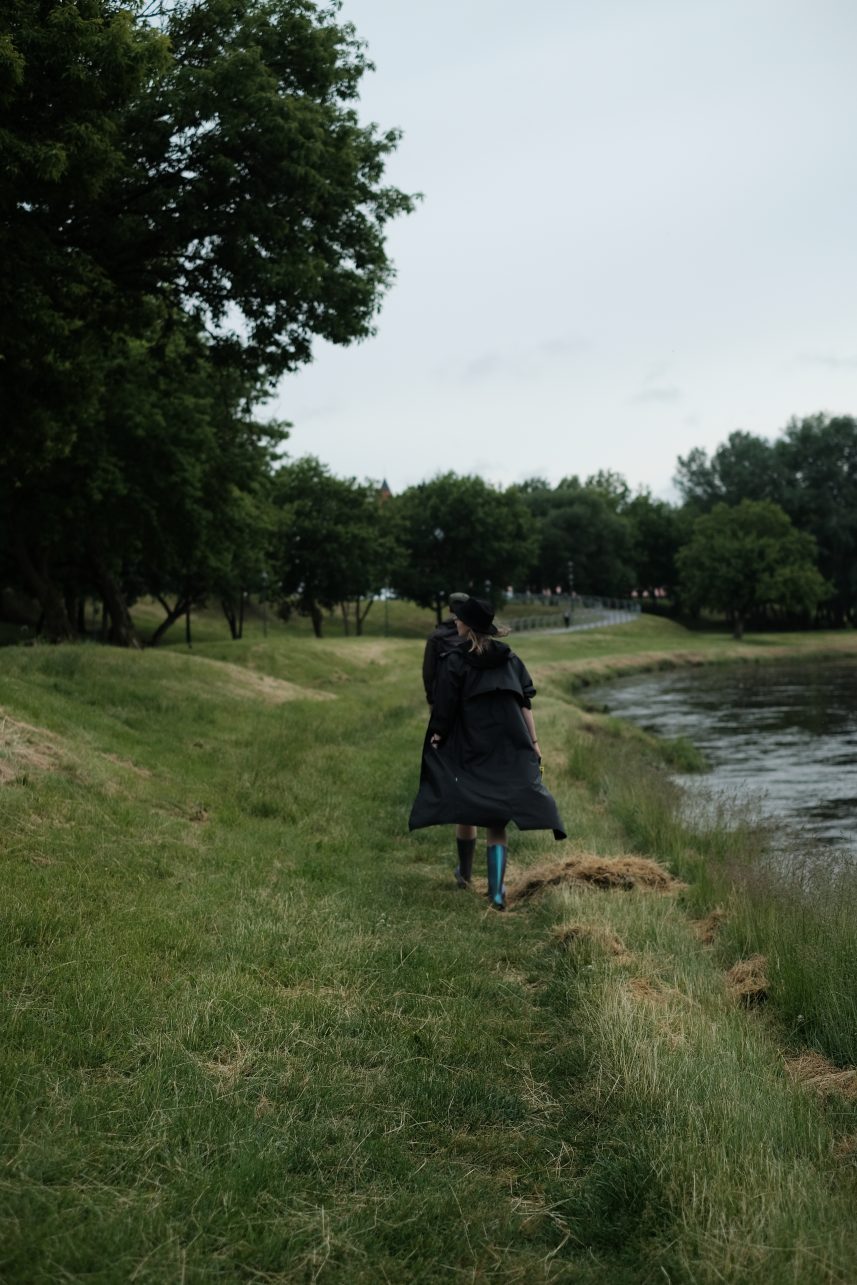
Both of you are from Kaunas and you know every nook and cranny of this city. Imagine that your new project is to create a perfume called Kaunas. What scents would appear in the bottles?
Justinas: Linded trees of Laisvės Avenue.
Rasa: I think so too! Linden trees and wet asphalt. I would also add some car oil and coffee scents. I have lived in more than one district and in each of them the smell was different. It smelled like bent grass and hay near Dainava Park because the meadows were not trimmed and grew wild, way above our heads. Asphalt and wet grass – these were the smells of my childhood. Now the city smells different.
